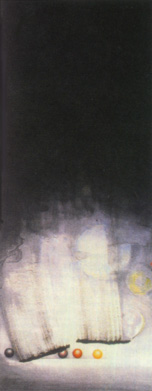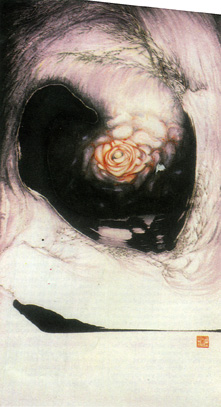In the beginning there was the essence...
And the spirit wandered on lesser waters, above the abyss it wandered...
The immensity of space a bible-black canvas...
One name was spoken and light shone on germinal forms, modelling their shape in the darkness of the night.
This is how we would approach Irene Chou's painting.
She takes us on an overwhelming return (rediscovery) voyage back to our own essence, our previous forms: inquisitive, moving and whirling in her search for a cosmic genesis, while shapes are flowing spontaneously in their wide dashes of nocturnal paint, an instant flash of light crashing down at incredible speed, an explosive germination set against the ancient and endless night.
The first comment that we dare utter about Irene Chou's paintings is that it reveals the artist's intelligence in her selection of a thematic and well defined universe that so marvellously fits her skills. If, on the one hand, the freely expressed gestures end up flooding huge paper surfaces with depths of unsettled and shapeless blotches, on the other hand it is her way of building a screen to expose the primordial figurations of a throbbing cosmos, taken by surprise at the very moment of its conception. These forms are unwrapped before us by means of an expert and wise technique, sober in managing resources and colour, but emphatic on keeping the gesture always alive. And this gesture encompasses within itself a wider motion that eventually weakens and fades out, and in so doing, brightens and shines in spaces which are left there, blank, to absorb a laborious, detailed and accurate trait.
This is the key-reading to the illusion of perpetual movement so well captured in Irene's paintings, an almost paradoxal motion in that although drawing quietly to an end, it is so full of excitement. It is a motion filled with the sort of peace that fills all impatient substances when they finally begin to perceive their shape - the fixation of the spirit on the chaos of substance.
But even then, one can feel and witness an omnipresent vibration and the physical contraction of matter, the pulsing vital juices, the waving of fluids as if some nocturnal heart was the centre and never ending beginning of life and shape, a mysterious Being, veiled somewhere.
Thematically, Irene Chou's paintings could be described as "hyperbolic" or cyclic, because her language is a daring loop set between two borders of the Unknown, between two opposite begin-end poles, Alpha-Omega of effluence and final destination of everything.
Paramount, extremist painting -because nothing can survive between two extremes. Disregarding definite and individual shapes, her painting propels its drive from the shades of embryonic modes towards the furthest nebulae of a pre-destined posterity.
An Apocalyptic Genesis.
 Infinity 7
Infinity 7
Thus this hint, this innermost apocalyptic, abysmal, frenzied hint exhuding from the canvas, from the plasma surface which germinates its anxiety for a metamorphosis, for evolution, and thin into a slow whirl of promised shapes.
And then, the plasma falls, explodes downwards like a meteor, faints and races again in a tidal wave, a profuse bleeding of paint. Every now and then, we see ourselves as if witnessing the thunderous universe of a cosmic germination erupting on a laboratory lamella, or as if looking through the lens of a telescope that sees as far as the beginning of time, where seminal vital secrets are revealed or the "cosmic egg" explodes starting not so much on a voyage through vast galactic plains, but rather along the depths of inner oceans.

Infinity13
That is why the cycle depicted in Irene's painting has only room for two seasons (no Summer nor Autumn): it blasts off radically from a nature under Capricorn - clad in Winter, subterranean, where life is in suspended animation - to bloom into a Springtime mood, but where an ontological journey flows in the opposite direction, from the created to the creator.
Here is a feminine painting because of its first and foremost fascination with, and handling of, the magnificent universe of mater and matter; so typically Chinese in privileging the "yin" and, thus, so watery, nocturnal, lunar.
Also feminine are her symbols: the choice of the exact moment for a simple incubation; the latent restlessness - because rebellion is a feminine principle; the resort to crystallization, when in pain or in triumph, in round, mini-spheric, ovular shapes, corollae and pearls secluded in their uterine cavities; the serene, subtle, ductility of the spirals when revealing the powerful airflow which dictate their geometry.
Technically, her painting is controlled. The shouts, the bleeding, the explosions, the tidal wave of paint (disguising in its visual simplicity how difficult it was to tame it) soon find order amid the shocking contrast of lines that thin away in a filigree of veins, lianas, spiralets, umbilical and circulatory capilarities, lymphatic and so filled with life, that only an industrious, patient and trained hand can capture.
As we don't know enough about either the artist or the course of her work, we don't dare to tell, reviewing this latest collection of her paintings (almost all named "Infinity"), what is simple thematic formalism from what may be a report on her introspective probing, and what is discovery from what has been there all along that enabled her to perceive the other side of reality which lies beyond the superficial world of shapes. That is, we cannot ascertain the extent of her journey since the introspection actually led her conception of archetypes and, from there, further on into the very beginning(s).
We are, however, right in affirming that Irene Chou is on the verge of an abyssal frontier which she has (will) overcome as long as she pursues the cathartic exercise of freeing her paintings of figurative representation that is, whenever she is able to ignore accidental similarities to set on her search for the absolute real each time that she probes deeper and deeper beyond the veils of mystery, to plan or discover her own visions of shape(s).
It is this in abstraction exercise that will, irreversibly, tempt her if not as a way out, then certainly as a way into a labyrinth of which only she will know the twists and ends of, if ever, how to find a way back.
Nevertheless, and staying away from such daring incursions into the artist's cosmos, her exploratory work of new approaches is worth referring, in that it proves (with considerable original merit to Irene) that Chinese painting is not a pond of stagnant waters but, well on the contrary, it is full of potential. And this potential will show and bloom each time that talent strives to enrich it with other Art traditions and forms.
Translated, by Luísa Vieira Guedes.
start p. 79
end p.